Brightest's 2022 Supply Chain Sustainability Improvement Guide
The Growing Importance of Supply Chain Sustainability
Responding to rising pressure from customers, ESG investors, regulators, and other stakeholders, more companies are auditing and working to improve the safety and sustainability of their supply chain. According to CDP, McKinsey, and our own internal data, a company’s supply chain’s greenhouse gas (GHG) emissions are, on average, 5 to 25 times higher than its direct emissions, making value chain sustainability and Scope 3 critical priorities for organizations taking action to decarbonize, reduce their environmental footprint, de-risk their brand, and improve ESG performance.
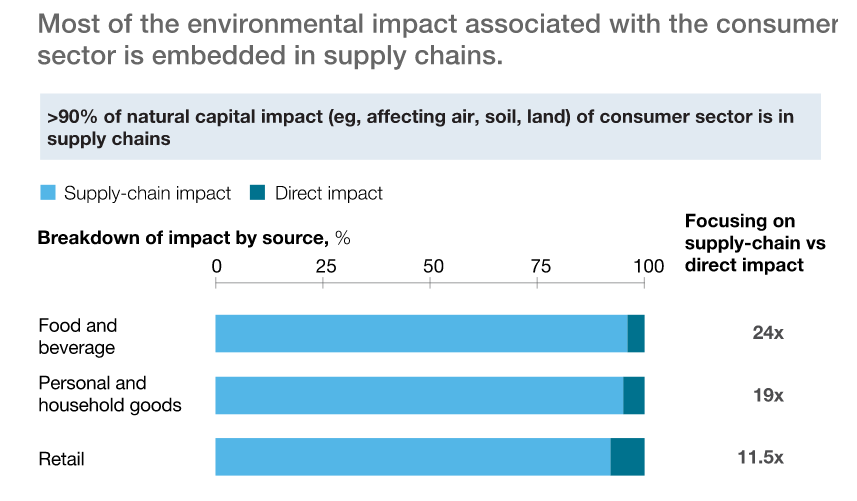
Source: McKinsey
And while 2021 was full of news of supply chain shortages, behind the scenes many leading organizations continued or even accelerated their supplier sustainability programs during COVID-19.
Since the start of COVID-19, my firm's commitment to supply chain sustainability has:
Source: MIT. N=1,557
Sustainable supply chain management is complex. It requires a holistic view of all the partners, processes, logistics, and raw materials involved in manufacturing and delivering your products to customers, plus the ability to track, collect, and connect data at each step. It also involves use of procurement influence to shift suppliers in sustainable directions. By reducing partners’ Scope 1, 2 & 3 emissions, you limit your company’s Scope 3 emissions.
But supply chain sustainability isn’t just about risks and challenges. It also presents historic opportunities to make and distribute more appealing, durable, valuable, and differentiated products, invent (or reinvent) new products, reduce costs, protect the environment, and elevate your company’s brand. Products and packaging can become biodegradable, compostable, or even upcycled from other products’ waste. The entire world benefits - both now and in the future.
Take Nike, the world’s leading shoe brand. By changing how some of its shoes are made - thereby reducing the labor costs and materials used - Nike increased company-wide profit margins 0.25% (almost $50 million) via more sustainable product design and supply chain practices.

The Nike Zoom Alphafly Next Nature shoe uses at least 50 percent total recycled content by weight. Source: Nike
Similarly, global food company Unilever estimates it loses over €300 million a year due to worsening water scarcity and declining agricultural productivity caused by climate change. But on the flip side, adopting more sustainable sourcing practices has helped the brand realize over €1.2 billion in cost savings since 2008. More direct examples of the financial benefits, costs, and risks that surround sustainability and the climate crisis.
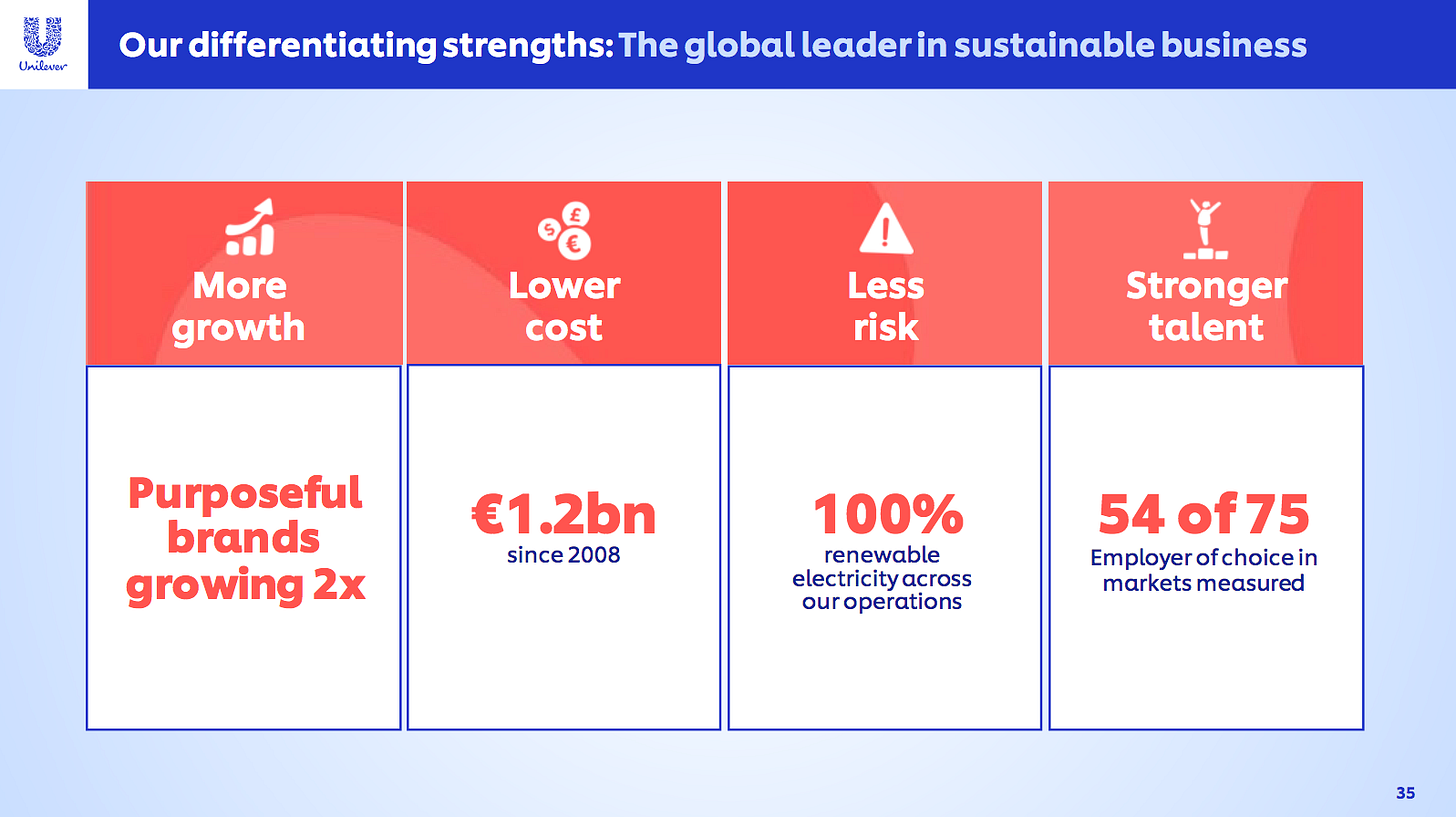
Source: Unilever
For companies looking to embed fair labor practices and environmental responsibility throughout their supply networks, here are some learnings, observations, and examples to help you cut through the complexity and create a more sustainable supplier ecosystem.
Here are Brightest's seven steps to audit, assess, and improve the sustainability of your supply chain:
- Achieve better supply chain transparency to set priorities, assess risks, and target opportunities
- Audit your products and conduct LCAs
- Identify efficiencies and optimization opportunities
- Set better standards (and help your suppliers meet them)
- Adopt and implement closed-loop and circular economy models
- Measure your environmental sustainability data
- Make sure your organization isn’t sabotaging its own sustainability efforts
1. Achieve better supply chain transparency to set priorities, assess risks, and target opportunities
For most companies that make and sell physical goods and products, your value chain will follow this pattern or structure:
Simplified Sustainable Supply Chain

As the old saying goes, you can't improve what you don't understand or have the ability to measure. If your company doesn't have a supplier and vendor database or tracking system, you need to work with IT and operations to set one up. Many traditional supply chain management systems, ERPs, and databases aren't designed for sustainability reporting or ESG metrics, so make sure you take that into account, or use a dedicated supply chain sustainability system like Brightest.
Define and agree on your key supply chain sustainability indicators early on in the process. Find the right balance between your internal goals and science-based sustainability targets, global sustainability reporting standards, supplier ESG surveys, and trusted third party advice to determine what to measure (and how). We recommend considering at least these themes as a starting point:

If your organization's operating at scale, it's likely your supply chain's a lot more complex than a simple diagram. Apple, for example, works with nearly 1,000 Tier 1 suppliers around the world to manufacture iPhones and Macbooks. However, sustainability efforts typically benefit from focus and simplicity, so start by engaging your strategic, long-term Tier 1 suppliers and direct contract relationships. Meet with them about conducting a supplier sustainability survey to gather data and insights on their material business practices, operations, and environmental footprints. Try to understand what they do and don't measure. And educate them on why sustainability matters to your business and theirs.
Look to supplement your direct supplier engagement with perspective and data from other stakeholders as well. Apple anonymously surveys nearly 200,000 workers at its suppliers facilities about their working conditions and experience, across 135+ factories. Work with human rights, trade, municipal, and grassroots organizations in the countries your suppliers are located to asess the full picture.
Once you have visibility into your top Tier 1 suppliers, work your way toward better understanding your Tier 2 suppliers and subcontractors. Primary suppliers regularly subcontract to other suppliers and purchasing agents, particularly in retail, apparel, and "fast fashion." Unfortunately, these Tier 2 and Tier 3 suppliers often operate with very little oversight or consideration around worker human rights, workplace safety, or the environment.
Your ultimate output should be a sustainability "scorecard" for each supplier, and a risk matrix, database, and program strategy encompassing your supply chain partners, priorities, risks, areas for improvement, and aggregate environmental footprint. Once your company knows where its supply chain issues and gaps are, you can set goals, implement supplier programs, work to influence existing partners, and consider establishing new relationships with more sustainable ones.
You have to start somewhere, and we've seen dozens of major global brands (and some of the world's largest procurement organizations) increase their focus and investments in supplier sustainability and transparency further in 2022, including Amazon, Apple, Disney, Nike, Target, Walmart, and many others. We expect this trend to continue and broaden in the coming years, influencing more upstream suppliers and partners to comply with better ESG standards and labor practices.
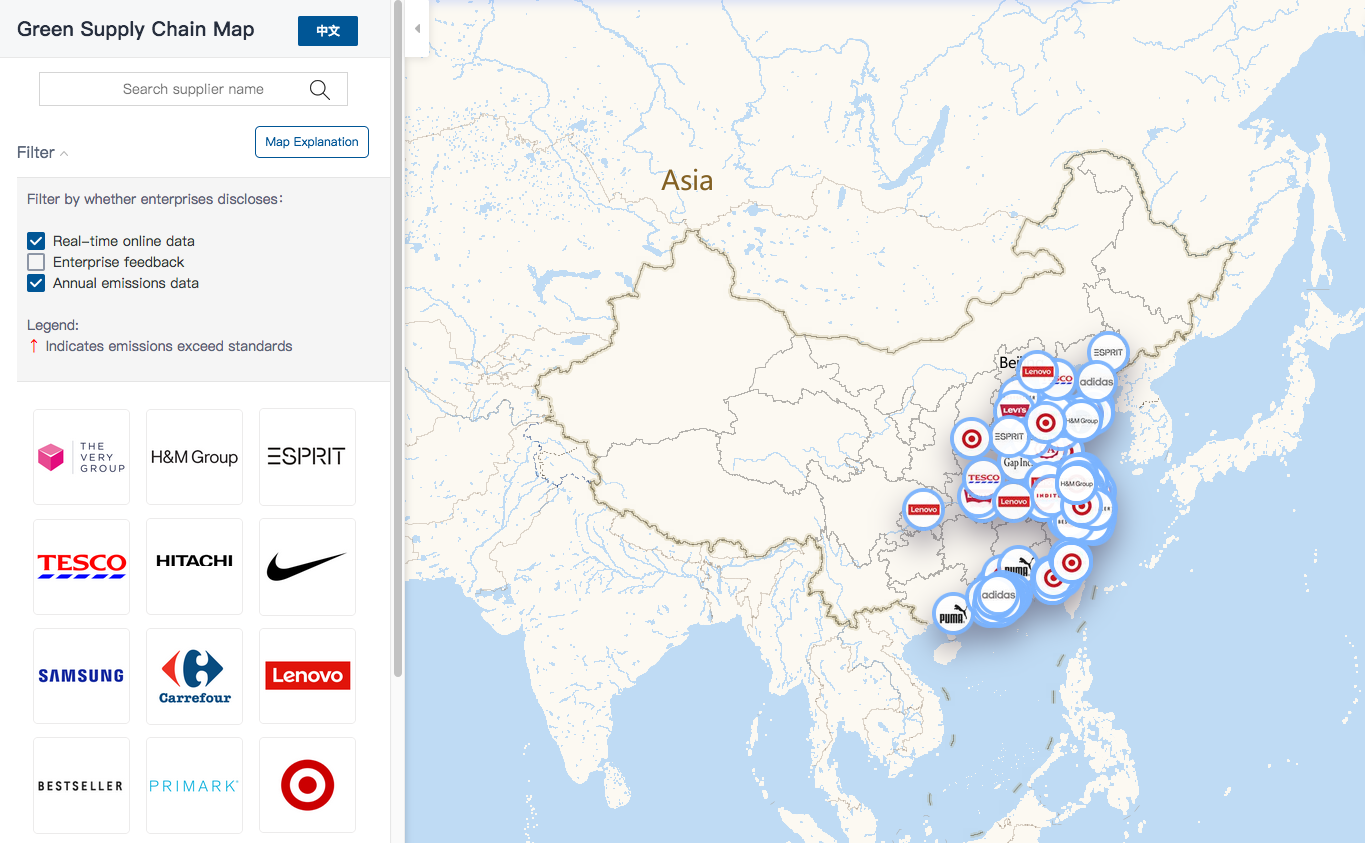
Supply chain sustainability mapping in China. Source: IPE
Remember, this work is challenging, and most organizations are undertaking it right now. In a recent survey by The Sustainability Consortium, a non-profit dedicated to improving the sustainability of consumer products, less than 20% of the 1,700 respondents said they have a comprehensive view of their supply chains' sustainability performance. More than half reported being unable to determine the top sustainability issues in their supply chains.
2. Audit your products and conduct LCAs
Beyond assessing your suppliers, take steps to investigate and understand your products through lifecycle analysis (LCA) projects and requests. Trace and link materials to your different suppliers, and work to understand each component's environmental footprint. From there, you're better positioned to understand the right levers to improve product-level sustainability (and, often, costs) in the context of your supply chain strategy. A product carbon footprint analysis is one type of LCA, so decide how narrow or broad your lens needs to be.
For example, LCAs can guide an LED light bulb manufacturer to replace their light bulb's aluminum with recycled aluminum, or even replace aluminum completely with a less carbon-intensive material like glass. A CPG brand might prioritize compostable, plant-based or post-consumer recycled (PCR) packaging. A product traditionally made from plastic may not need to use plastic as a raw material at all.
For an apparel brand like Levi's, an LCA for a pair of jeans will consider the environmental impacts of cotton all the way through their clothes being washed, dried, and discarded or recycled by customers.
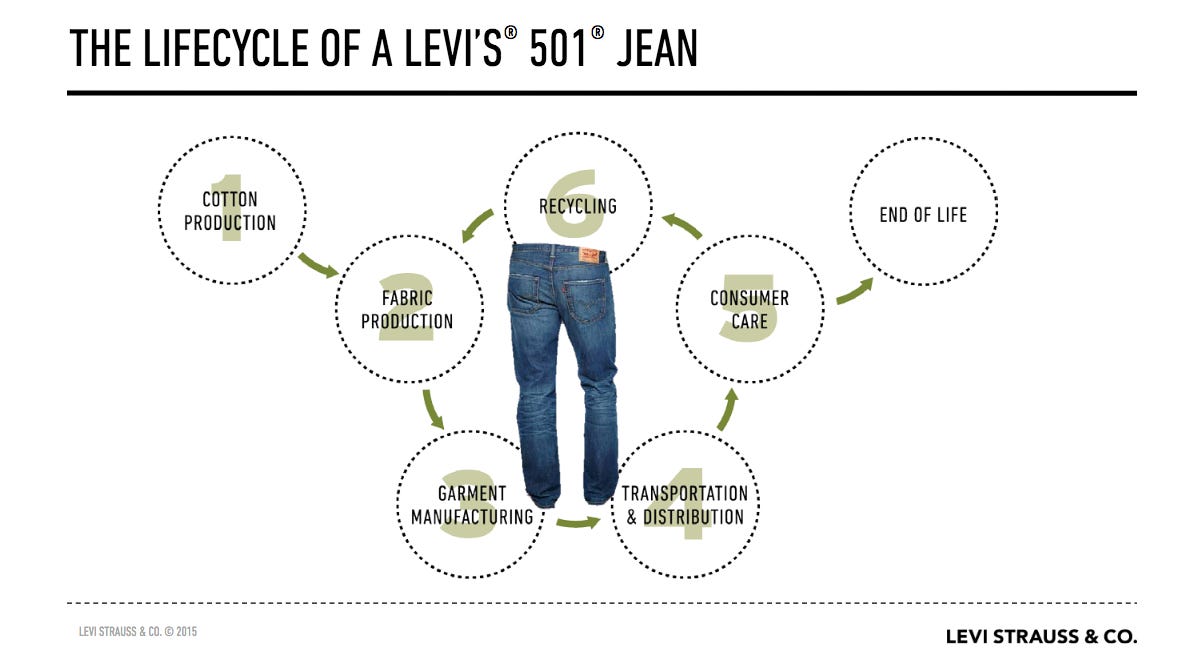
Source: Levi's
Starting with your leading SKUs, focus on four elements:
- An inventory of all the materials that go into making the product
- All the supply chain steps and processing required to transport and turn your materials into finished goods, then deliver them to customers
- Your product's end-of-life treament and steps. Is it discarded, recycled, up-cycled? How sustainable or "circular" is the product lifecycle?
- The environmental and social impacts at each step for each input
Make sure to consider your product, each input ingredient, and its related environmental impacts and intensity across:
- Raw Material Cultivation, Sourcing, or Extraction
- Manufacturing & Processing
- Transportation
- Retail & E-Commerce
- Usage
- End-of-Life & Waste Disposal
In their initial 501 Jeans LCA, Levi's identified six material LCA themes (and metrics) to measure the product's lifecycle impact.
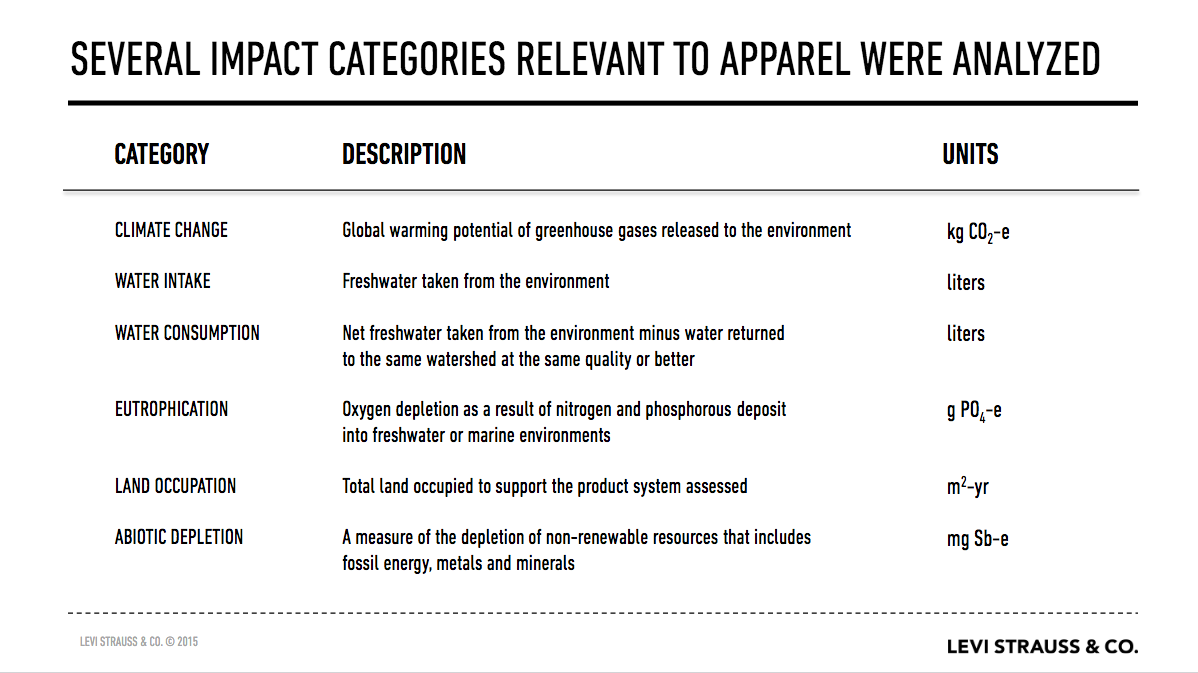
Source: Levi's
Define a scope, inventory your materials, inputs, ingredients, and packaging, map everything you can to its associated supply chain, and focus on (a) the biggest or most material positive changes you can make, as well as any (b) quick, easy wins. Make sure to request LCAs from your own suppliers as well for raw materials. More large brands are asking vendors and suppliers for product LCAs, so the more thorough you are now, the better prepared you'll be to secure future business.
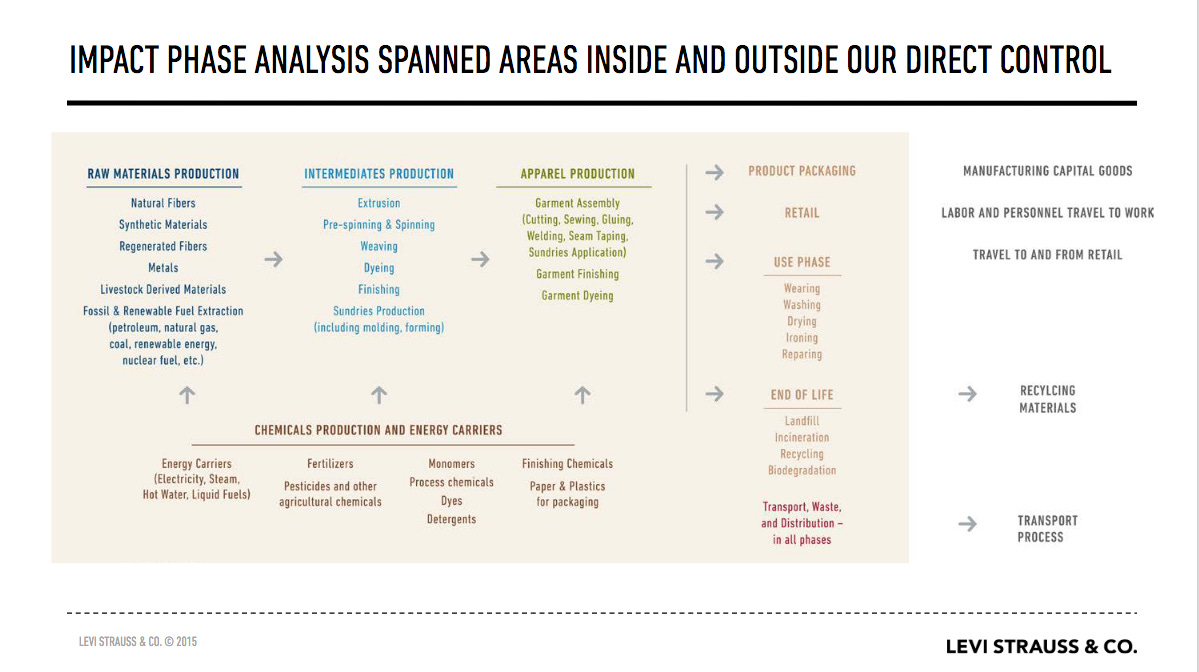
LCAs can also get very complex very quickly, and there will always be data gaps, uncertainties, and assumptions. No LCA is perfect, but the better you understand your products within a certain confidence interval, the better equipped you and your organization will be to ask smart questions, make better decisions, and engage your suppliers and other stakeholders more effectively on sustainability and other issues.
3. Identify efficiencies and optimization opportunities
Sustainability is based on principles of balance, regeneration, and efficient use of resources - many of the same qualities of an effective supply chain. While identifying specific opportunities will vary based on your business, industry, and geographic footprint, revisit the same supply chain and LCA steps to look for material opportunities and cost savings, then embrace creativity, engineering, and innovation.
Examples might include:
- Implementing energy efficiency and renewable energy projects at owned facilities, and encouraging, advocating, or even financing them at leased and third-party sites
- Sourcing raw materials closer to the plant that manufactures it
- Sourcing a greater percentage of recycled and upcycled raw materials for products and packaging
- Improving and reducing the emissions intensity of your raw material transportation
- Recycling and re-using water, waste, and other byproducts from operations
- Helping your customers re-use, recycle, or return their used products for more sustainable end-of-life treatment
- Partnering - and even financing - to implement sustainability improvements in strategic parts of your value chain
Recognizing denim's a water-intensive process, retailer Everlane adopted a closed water system using high-efficiency jet washing machines. The washers only lose 0.4 liters to natural evaporation, and the rest is recycled, compared to 1,500 liters of water for traditional denim. A filtration process extracts contaminents from the water, and the rest of the water can be re-used. The washing facility's powered by 5.3 million kilowatt hours (kWh) of solar power each year, allowing it to operate at only 20% of the CO2 footprint vs. a conventional fast fashion facility.

Source: Everlane and Saitex
Terrapin brewery, a beer brand in Athens, Georgia, takes similar conservation steps with its water and waste. Recognizing its brewery waste has agricultural applications, Terrapin's even created a new revenue stream by helping local farmers buy and use the brewery's waste output.
4. Set better standards (and help your suppliers meet them)
To codify sustainability within your supply chain and procurement practices, design, communicate, and use a supplier code of conduct the reflects your organization's sustainability targets and ESG goals.
What you prescribe is up to you and should fit the needs and realities of your business, but at a minimum include requirements for waste disposal, hazardous materials, energy and water use, as well as human rights and labor practices.
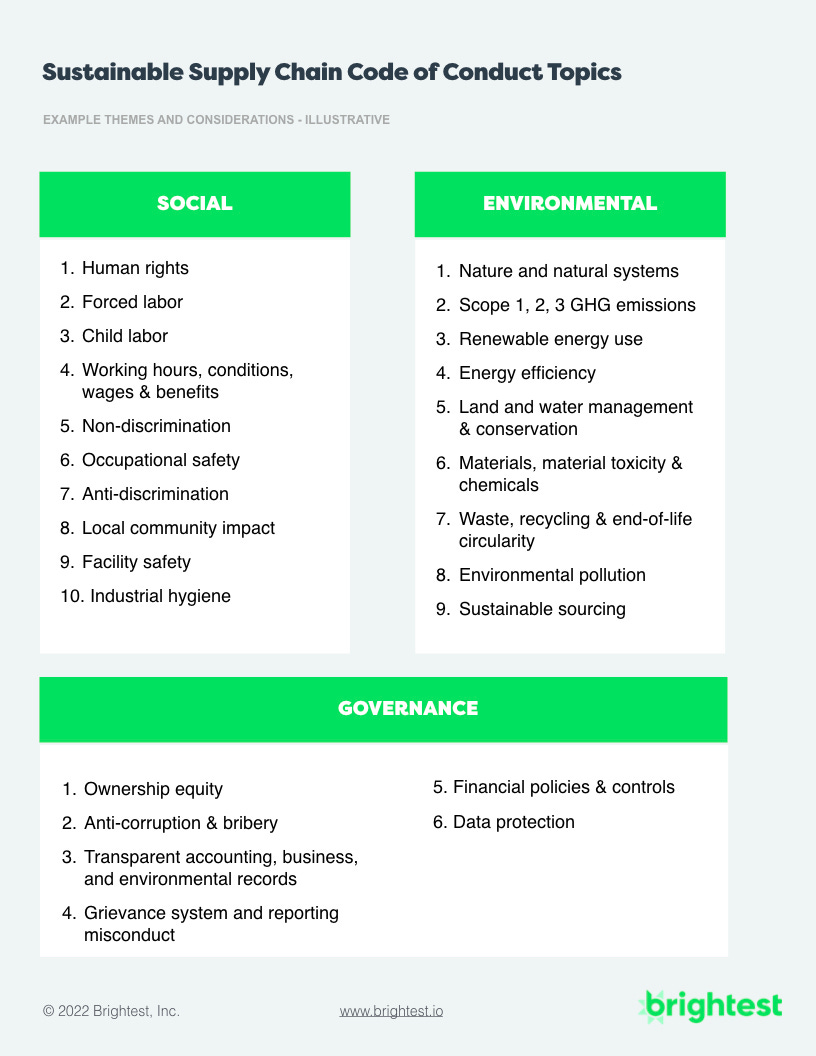
Supplier relations is an ongoing dialogue, and your organization will have varying degrees of influence in a specific value chain. When working with suppliers on sustainability initiatives, it's important to be clear, consistent, and understanding:
- Engage your CEO, CFO, or Chief Procurement Officer (CPO) in this communication process. Make it clear to your suppliers this is a company-wide initiative and top priority.
- Ask your suppliers what they're doing currently around sustainability and human rights, and what policies and controls are already in place now. In many cases, your larger and more strategic suppliers will already have been approached by their other value chain relationships around similar initiatives.
- Educate each supplier on why sustainability matters for your business and stakeholders, as well as why investing in sustainability is beneficial to their business as well. Cite other brands and examples. Highlight the opportunities and risks of inaction.
- Also work to engage your Tier 1 and priority suppliers around their supply chains. Who are their suppliers? What are their procurement policies? Where are the biggest lower-tier risks, issues, and opportunities for improvement?
Once you've established one or more sustainable supply chain programs, work with your suppliers to implement best practices:
- Introduce your Sustainable Supply Chain Code of Conduct and policies up front. Make it publicly available on your website. Include it in contracts and RFPs. Track which suppliers have reviewed and signed on.
- Help suppliers establish long-term sustainability goals and science-based targets.
- Include your suppliers' suppliers within these sustainability programs.
- Request each supplier designate a sustainability lead and primary point of contact on their staff to work with you to extend the sustainability program(s) to lower-tier suppliers.
- Offer training to suppliers and provide them with incentives for implement sustainability practices and building capacity
- Offer co-investment or supportive financing to help your strategic suppliers implementing sustainability practices like renewable energy, energy efficiency, and closed-loop processes (if your organization has the means).
- Conduct annual reviews and solicit feedback from your suppliers on how to improve.
- Use independent audits, verification steps, and data checks.
For example, in 2021 Hewlett-Packard (HP) launched a new Sustainable Bond Framework, which the company will use to issue bonds to help finance HP sustainability projects. The company plans to issue up to $2 billion in sustainable bonds, and one use of proceeds will be projects that help decarbonize its supply chain. Similarly, Unilever and Campbell Soup Company offer their farmers technologies, guidelines, and products to help them optimize their fertilizer and water use and improve soil conservation.
5. Adopt and implement closed-loop and circular economy models
In sustainability, closed-loop systems reuse and recycle raw material outputs as inputs back into the manufacturing process.

Source: Catherine Weetman
For example, beer brewer Sierra Nevada uses a closed-loop approach in the company’s Chico, California facilities. The waste generated from brewing beer is composted back into the soil used to grow new barley and hops to make future beer. When consumers recycle the company's beer cans, the aluminum can be further salvaged and re-used for future products.
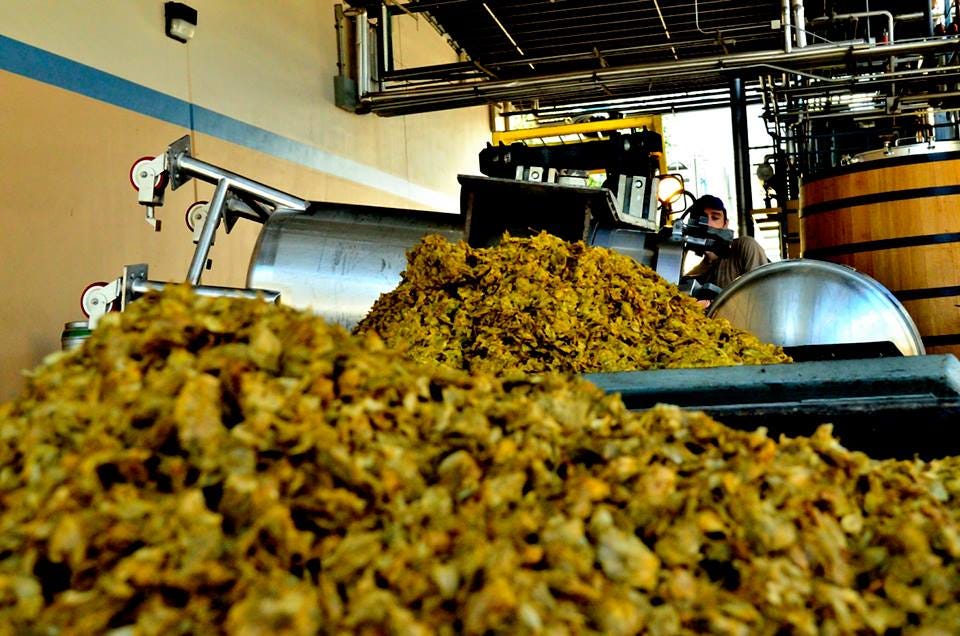
Source: Sierra Nevada
As you improve your supply chain and raw materials understanding through LCAs, audits, surveys, and other projects, look for opportunities to adopt or reinvent circular processes. Often, circular and closed-loop processes not only decrease your organization's environmental impacts, but also lead to cost savings or even new revenue streams.
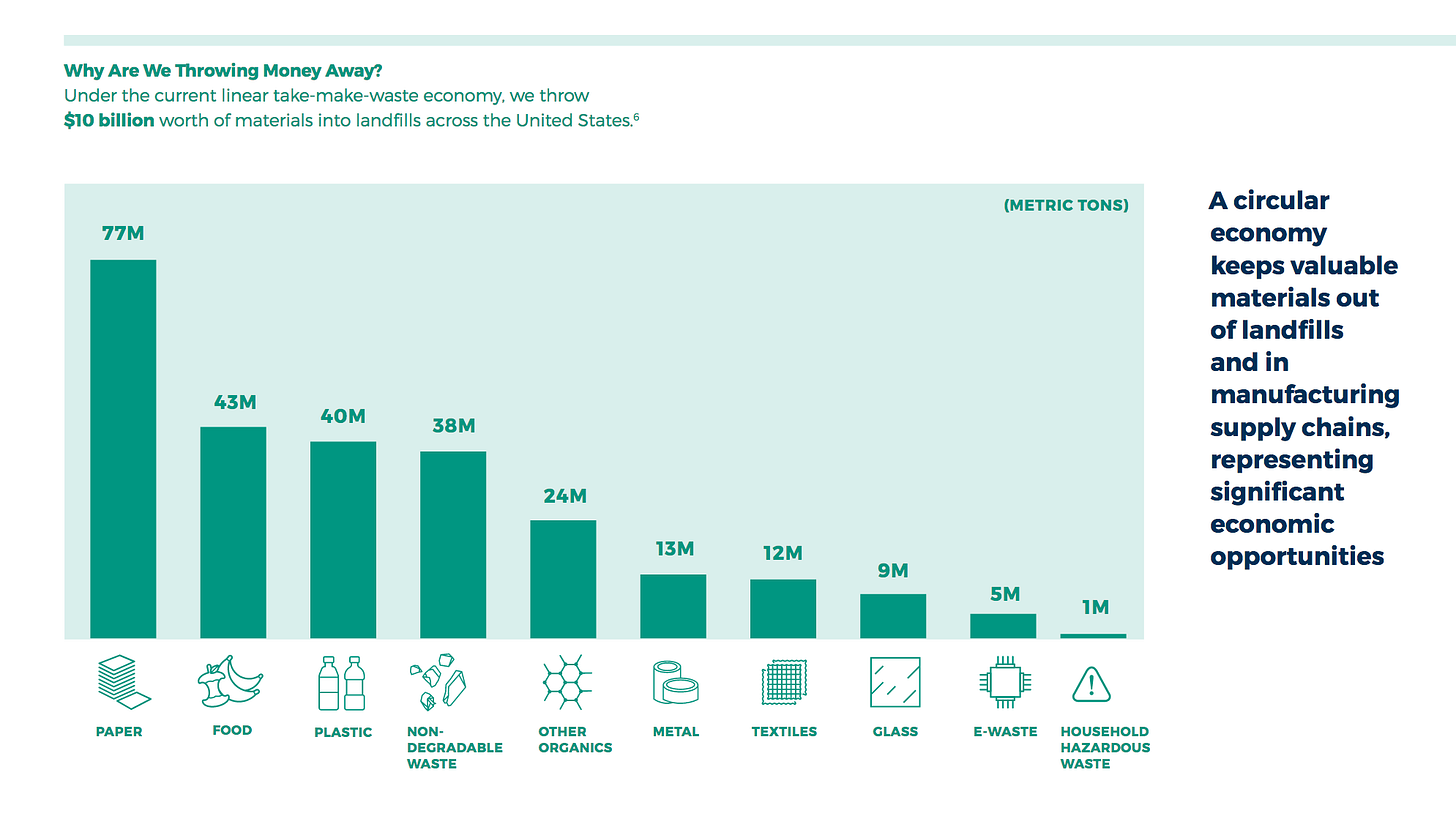
Source: Closed Loop Partners
Many common product ingredients and inputs like water, glass, and aluminum are almost infinitely recycleable with the right process, making them perfect for closed loop and circular engineering. Even "imperfectly circular" materials like paper and plastic can be re-used, reduced, and recycled, while opportunities to compost food waste are immense.
Beyond materials, closed loop strategies also extend to business models. Dozens of global brands including Procter & Gamble, Nestlé, Unilever, PepsiCo, Mondelēz International, and Danone are nowing using the Loop recommerce platform, which distributes the brand's products to customers in durable packaging that is collected, cleaned, refilled, and reused after use.
Rent, recommerce, refill, and reuse-based circular product delivery models will increasingly become an accepted - and, perhaps in the near future, required - part of doing businss.
6. Measure your environmental sustainability data
From assessing supplier risks to understanding product-level environmental impacts, accurate data is a critical component for better supply chain sustainability. You need to collect, organize, manage, and take the steps to understand the data your organization gathers throughout its value chain - no easy task given the scale and complexity we've already outlined.
According to a 2021-2022 study by Accenture and the United Nations, 63% of CEOs say difficulty measuring ESG data across their value chain is a barrier to achieving sustainability in their industry.
If your organization doesn't already have supply chain sustainability goals and targets, start by determining what they should be and how you'll track them. Most organizations will set goals around metrics and indicators like:
- Overall supplier performance and risk vs. your company's code of conduct and corporate sustainability targets
- The percentage (%) of suppliers that have completed an environmental assessment (and passed)
- The percentage (%) of suppliers that have received material third party certification
- The percentage (%) of suppliers that have adopted emissions, water, and other science-based sustainability targets
- The percentage (%) of first-tier suppliers by spend and materials quantity powered by renewable energy and other closed-loop processes
- Your supply chain's greenhouse gas (GHG) emissions
- The number of suppliers completing corrective action plans
All of this information should feed an overall supplier sustainability rating and risk assessment system so you're able to see and rank suppliers based on their environmental performance (and contribution to yours). If you need a system to gather and centralize this information (and don't have one in place), Brightest offers a unified set of supply chain sustainability tools to help your organization set goals, engage suppliers, run environmental surveys, and track performance.

Don't underestimate the effectiveness of quality technology backed by a thoughtful strategy and good supplier relations for overcoming supply chain transparency challenges. According to McKinsey, "in our observation, companies that instituted control towers and other digital solutions before COVID-19 were better able to navigate the crisis than those that had not. The companies had better tools, data, and visibility into their supply chains, allowing them to identify and move early on both problems and opportunities."
Target's Chief Risk Officer Don Liu backs up that assessment: "We find ourselves not only learning the political environment in which we work, not only at the national level, but the international level. We have to invest in technology because responsible sourcing requires us to know the ingredients that go into our products and to be able to do due diligence on the vendors [and] the conditions under which vendors’ employees are working."
7. Make sure your organization isn’t sabotaging its own sustainability efforts
While we've shared many examples where an organization's sustainability goals can operate in harmony with its financial goals and business objectives, there are times when sustainability may find itself at odds with other, competing needs and priorities. We might want to order materials in advance and ship them as cost and carbon-effectively as possible, but perhaps there's a last minute rush to fulfill a large order and it needs to be air shipped overnight instead. These tensions will - and do - exist.
While these challenges can be politically sensitive, it's important to recognize and speak openly about them wherever possible. Often, less sustainable decisions happen inside organizations because the person or team making the decision doesn't realize there's a more environmentally-friendly alternative - or doesn't have the right framework for a full cost-benefit analysis. Internal sustainability education and stakeholder engagement is just as important as your supplier communications.
The more your organization aligns its sustainability targets with its operating goals, policies, and brand purpose, the easier it is to point out inconsistencies and assign corrective action. If there is incompatibility between sustainability and ESG targets and other operational motions, you may need executive stakeholder support to balance these competing priorities and clarify decision-making.
If your company makes or sells physical products, your supply chain is the foundation for your organization's overall sustainability performance. Achieving supply chain sustainability exellence is complex, and does require internal capacity, resources, and investment. But, done correctly, it can boost everything from your firm's brand and reputation to employee morale and retention, operating financials, and risk management efforts.





